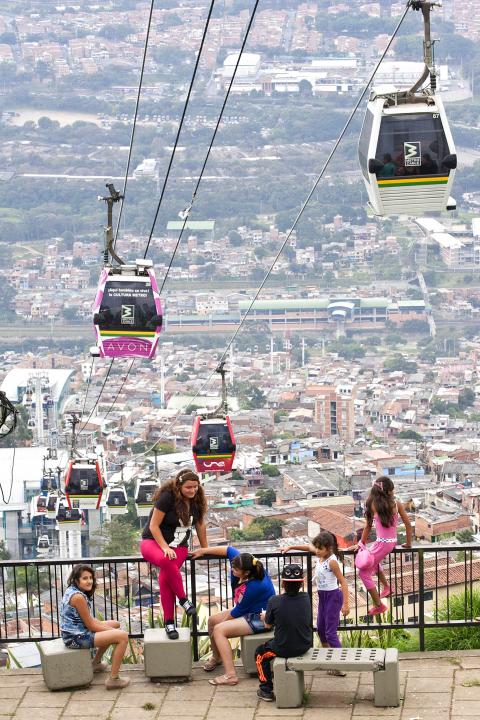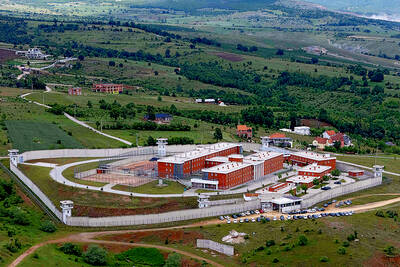Medellin’s “cable car of the poor,” soaring over the slums of Colombia’s second-largest city, has revolutionized this former drug lord fiefdom and inspired other violent Latin American cities.
The city of 2.5 million, long considered one of the most dangerous places on the planet, has seen crime rates fall and neighborhood life return thanks to new public services in some of its poorest areas.
At the center of the strategy to reclaim the slums is a transportation system that now includes subways, the cable car, hillside escalators and even public libraries at metro stations.

Photo: AFP
It “creates a sense of belonging,” said Juliana Correa, communications director for the Metro de Medellin.
“Before, the people of the hillside slums would say, ‘I’m going down to Medellin.’ Now they feel part of the city,” Correa said.
At the Acevedo station, where the subway and Metrocable meet, a huge library welcomes residents from the gritty neighborhoods surrounding it — and also tourists who ride the cable car for the spectacular birds eye views of the city.
“This was a very violent neighborhood, not that busy, so there was no transportation,” Luz Valdes said at a small grocery store just outside the station.
“Now there are many jobs and many tourists from far away visit the neighborhood because it’s very nice with the Metrocable and library,” Valdes added.
It is all a far cry from just a few years ago.
Medellin went through “a dark, long and painful night,” Medellin Mayor Anibal Gaviria told reporters, referring to the 1990s, when Colombian drug lord Pablo Escobar unleashed a wave of violence.
Then, the city had a startling homicide rate of 380 per 100,000 inhabitants and the dubious distinction of being known as the murder capital of the world.
Last year, the murder rate was 10 times lower, according to the mayor.
Other studies support the claim that there has been a sharp drop in violence. To change the dynamic local governments have employed a kind of “urban acupuncture,” bringing to bear a welter of programs designed to reach long neglected shantytowns.
With an US$88 million budget this year, the plan provides transportation at critical points and promotes education, culture, health and the deployment of Colombian security forces.
The Metrocable opened in 2004, and the subway system has also added on a bicycle rental service.
The most striking initiative is a system of outdoor escalators that has served Comuna 13, one of the poorest and most violent areas in Medellin, since December 2011.
Instead of trudging up 350 concrete steps, residents take escalators now.
“Projects such as the Metrocable, the metro, the escalators and the libraries imply the presence of the state in places in the city that had been abandoned,” Gaviria said.
None of this is to say that Medellin does not still have considerable problems.
In Comuna 1, which is served by a cable car, gangs maintain a discreet presence.
Yet Ferney Navarro, a resident of 32 years, said: “There is more control from the authorities. Seeing so many tourists coming, the government has had to tighten control. Before we were totally abandoned, but now we have more protection.”
A study by Columbia University in the US found the homicide rate in the slums of Medellin where Metrocable serves dropped by 66 percent between 2003 and 2008.
This decrease coincides with a sharp drop in homicides in Colombia — from 78 per 100,000 population in 1991 to 32 in 2012.
A secret of Medellin’s success has been its ability to adapt initiatives that have worked elsewhere in the world.
At the same time, the city has become “an inspiration for other cities living difficult times,” the mayor said.
Thus the Metrocable has been replicated in Curitiba, in southern Brazil, and Caracas.
Since 2010 in San Agustin del Sur, in the west of Caracas, a Metrocable carries more than 40,000 people a day on a nine-minute ride from the foot of a mountain to the populous neighborhoods overhead. That initiative’s success led Venezuelan authorities to begin building another cable car serving Mariche neighborhood in February 2012.

Packed crowds in India celebrating their cricket team’s victory ended in a deadly stampede on Wednesday, with 11 mainly young fans crushed to death, the local state’s chief minister said. Joyous cricket fans had come out to celebrate and welcome home their heroes, Royal Challengers Bengaluru, after they beat Punjab Kings in a roller-coaster Indian Premier League (IPL) cricket final on Tuesday night. However, the euphoria of the vast crowds in the southern tech city of Bengaluru ended in disaster, with Indian Prime Minister Narendra calling it “absolutely heartrending.” Karnataka Chief Minister Siddaramaiah said most of the deceased are young, with 11 dead

By 2027, Denmark would relocate its foreign convicts to a prison in Kosovo under a 200-million-euro (US$228.6 million) agreement that has raised concerns among non-governmental organizations (NGOs) and residents, but which could serve as a model for the rest of the EU. The agreement, reached in 2022 and ratified by Kosovar lawmakers last year, provides for the reception of up to 300 foreign prisoners sentenced in Denmark. They must not have been convicted of terrorism or war crimes, or have a mental condition or terminal disease. Once their sentence is completed in Kosovan, they would be deported to their home country. In

DENIAL: Musk said that the ‘New York Times was lying their ass off,’ after it reported he used so much drugs that he developed bladder problems Elon Musk on Saturday denied a report that he used ketamine and other drugs extensively last year on the US presidential campaign trail. The New York Times on Friday reported that the billionaire adviser to US President Donald Trump used so much ketamine, a powerful anesthetic, that he developed bladder problems. The newspaper said the world’s richest person also took ecstasy and mushrooms, and traveled with a pill box last year, adding that it was not known whether Musk also took drugs while heading the so-called US Department of Government Efficiency (DOGE) after Trump took power in January. In a

LOST CONTACT: The mission carried payloads from Japan, the US and Taiwan’s National Central University, including a deep space radiation probe, ispace said Japanese company ispace said its uncrewed moon lander likely crashed onto the moon’s surface during its lunar touchdown attempt yesterday, marking another failure two years after its unsuccessful inaugural mission. Tokyo-based ispace had hoped to join US firms Intuitive Machines and Firefly Aerospace as companies that have accomplished commercial landings amid a global race for the moon, which includes state-run missions from China and India. A successful mission would have made ispace the first company outside the US to achieve a moon landing. Resilience, ispace’s second lunar lander, could not decelerate fast enough as it approached the moon, and the company has